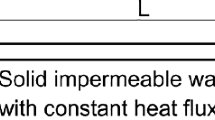Abstract
A local damping of eddy viscosity depending on the ratio of the production of turbulent energy to turbulence dissipation rate is proposed at the computation of flows in transonic axial compressors. The results of the numerical modeling of flows in compressor NASA Rotor 37 are presented, and the computed distributions of the increase in the total temperature and total pressure are compared with experimental data for different rotation frequencies. An increase in the accuracy of modelling was obtained in all considered regimes.
Similar content being viewed by others
References
B.E. Launder and D.B. Spalding, The numerical computation of turbulent flows, Computer Methods in Appl. Mech. and Engng., 1974, Vol. 3, P. 269–289.
D.C. Wilcox, Turbulence modeling for CFD, DCW Industries, 2000.
G.A. Gerolymos and I. Vallet, Wall-normal-free Reynolds-stress model for rotating flows applied to turbomachinery, AIAA J., 2002, Vol. 40, P. 199–208.
R. Chima, Comparison of the AUSM+ and H-CUSP Schemes for Turbomachinery Applications, NASA TM-212457, National Aeronautics and Space Administration, Langley Research Center, Hampton, Virginia, 2003.
R. Chima, SWIFT Code Assessment for Two Similar Transonic Compressors, NASA TM-215520, National Aeronautics and Space Administration, Langley Research Center, Hampton, Virginia, 2009.
J. Dunham (Ed.), CFD Validation for Propulsion System Components. Advisory Group for Aerospace Research report AR-355. Canada Communication Group Inc., Quebec, 1998.
S.B. Pope, Turbulent Flows, Cambridge University Press, Cambridge, 2000.
I.A. Belov, Modelling of Turbulent Flows: A Textbook / I.A. Belov and S.A. Isaev, Baltic State Technical University, St. Petersburg, 2001.
P. Bradshaw, T. Cebeci, and J.H. Whitelaw, Engineering Calculation Methods for Turbulent Flow, Academic Press, N.Y., 1981.
M.H. Bertram, Free Turbulent Shear Flows. Vol. II — Summary of Data, NASA SP-321, National Aeronautics and Space Administration, Langley Research Center, Hampton. Virginia, 1973.
L. Reid and R.D. Moore, Design and Overall Performance of Four Highly Loaded, High-speed Inlet Stages for an Advanced High-Pressure-ratio Core Compressor, NASA Technical Paper 1337, 1978.
R.D. Moore and R. Lonnie, Performance of single-stage axial-flow transonic compressor with rotor and stator aspect ratios of 1.19 and 1.26, respectively, and with design pressure ratio of 2.05, NASA. TP-1337, National Aeronautics and Space Administration, Langley Research Center, Hampton, Virginia, 1978.
K.L. Suder, Blockage development in a transonic, axial compressor rotor, NASA. TM-113115, National Aeronautics and Space Administration, Langley Research Center, Hampton, Virginia, 1997.
S.G. Cherny, D.V. Chirkov, V.N. Lapin et al., Numerical Modelling of Flows in Turbomachines, Nauka, Novosibirsk, 2006.
A.V. Rusanov, Numerical modelling of three-dimensional viscous gas flow in turbomachine with regard for unsteady interaction of blade apparatuses, Aviatsionno-kosmich. tekhnika i tekhnologiya. Vestnik Kharkovskogo aviatsionnogo instituta, 1998, Iss. 5, P. 104–108.
W. Vieser, T. Esch, and F. Menter, Heat transfer predictions using advanced two-equation turbulence models with advanced wall treatment, in: Proc. 4th Int. Symp. on Turbulence, Heat and Mass Transfer. Antalya, Turkey, 2003, P. 614–635.
H. Grotjans and F.R. Menter, Wall functions for general application CFD codes, in: ECCOMAS 98 Proc. of the Fourth European Computational Fluid Dynamics Conf. 1998 (K.D. Papailiou et al., Eds.), P. 1112–1117.
K.N. Volkov, Application of the control volume method for solving the problems of the mechanics of fluid and gas on unstructured grids, Vychislit. metody i programmirovanie, 2005, Vol. 6, P. 43–60.
T. Belamri, P. Galpin, A. Braune, and C. Cornelius, CFD Analysis of a 15 Stage Axial Compressor: Part 1 — Methods, in: ASME Conf. Proc. 2005, P. 1001–1008.
Ansys CFX-Solver Theory Guide / ANSYS Inc., Southpointe, 2006.
M.J. Raw, Robustness of coupled algebraic multigrid for the Navier — Stokes equations, 34th Aerospace and Sci. Meeting & Exhibit, January 15–18 1996, Reno, NV, AIAA 96-0297, 1996.
Author information
Authors and Affiliations
Corresponding author
Rights and permissions
About this article
Cite this article
Aksyonov, A.N., Shabarov, A.B. Modelling of turbulent flows in transonic axial-flow compressor NASA Rotor 37 with local weak-equilibrium damping of eddy viscosity coefficient. Thermophys. Aeromech. 16, 635–641 (2009). https://doi.org/10.1134/S0869864309040131
Received:
Published:
Issue Date:
DOI: https://doi.org/10.1134/S0869864309040131




